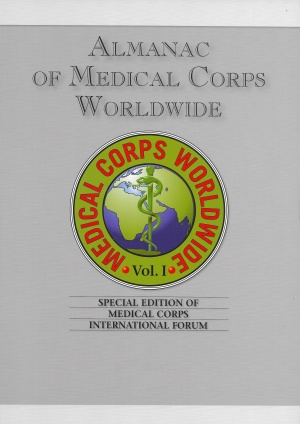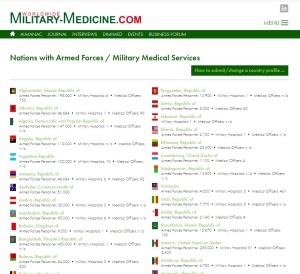
Overview: Martin Bricknell
The Military Medical Corps Worldwide Almanac
The Military Medical Corps Worldwide ALMANAC is the only publicly available, comprehensive summary of military health services throughout the world. Military health services are an important component of national armed forces, providing health support during military deployments, and also caring for military personnel and other beneficiaries in garrison locations. Military health services may represent a substantial component of government-funded health services and make a significant contribution to national disaster response. The ALMANAC celebrates the roles of military health services and is comparable to other separate indexes and databases of international armed forces and health systems. This short article provides a background to the ALMANAC and encourages readers and nations to contribute and use it.
The ALMANAC is published as a free good by Beta-Publishing which is a publisher and conference organiser focussed on the military and emergency medicine market. The first volume of the ALMANAC was compiled by Brigadier General (Rtd) Dr Lutz Bandekow and was published in print as a special edition of the Medical Corps International Forum in 2011. The cover of the first edition is shown at Figure 1. This provided information on 65 countries ranging from the Islamic Republic of Afghanistan to the Republic of Uzbekistan. The numbers expanded to 159 countries by the publication of the 2017 edition. I took over as Editor-in-Chief from Dr Bandekow in Spring 2021. I wish to ensure that his legacy is respected by keeping the ALMANAC up to date with entries from as many countries as possible and by developing the structure and content of the profiles of military health services.

Figure 1 Front cover of the first edition of Military Medical Corps Worldwide ALMANAC
The ALMANAC is now published electronically and hosted within the Military-Medicine.com website at: https://military-medicine.com/almanac/index.html. This is an open-source website that publishes information submitted by the Surgeon General’s staff for each country. This ensures that the information is authorised by each country and has been cleared by public relations and security branches. It is funded through advertising on the wider website. Electronic publishing allows timely updates to the profiles of national military health services and saves printing costs. A request for an update is sent to the Surgeon General’s office of each country in January each year. The editorial team change the published profile soon after the country has approved the final electronic version. Figure 2 shows ascreenshot of the main page of the ALMANAC.

Figure 2 Main page of the ALMANAC.
With a research student, Ryan Leone, and other collaborators,we analysed the content of each country’s profile in the ALMANAC in 2020 to determine the completeness of information and opportunities for comparison between countries. We found multiple topics that could provide very insightful analyses when comparing countries but also significant variation in the content of each profile. Clearly the size of a military health system depends on the size of the armed forces, but it is also influenced by the role of the public health system in the care of wider beneficiaries (spouses, children, wider family, veterans, nonmilitary defence employees and others). The organisational structure varies between tri-Service and single Service (Army, Navy, Air Force) command with an increasing trend towards a blended civil-military workforce for garrison health services, particularly military hospitals. Ensuring a sufficient workforce is proving increasingly difficult with various incentives for military service between countries and adding a civilian component to the defence healthcare team. In many countries, the military health system has an important role in professional education and medical research; some even have military medical schools, field training centres, and medical research institutes. The primary rationale for a military health system is to provide medical support to military operations. The scale and design of field military medical units is dependent on the national security policy and role of the armed forces in external and internal security. Many countries have adopted the military medical clinical lessons from the last 20 years of conflict that have been published in the academic literature. This includes first aid training for all military personnel, rapid evacuation under medical supervision, damage control resuscitation and surgery, liberal use of blood products, and military rehabilitation. Many countries have also increased their military mental health services to support those with mental ill-health as a result of military service. Additionally, there is often a close relationship between health services for serving personnel and veterans to ensure continuity of care after military service. All countries train their military medical personnel for pre-hospital and deployed hospital care with specific field and clinical training for the military environment. Finally, the history and culture of the military medical services is an important legacy and signpost to the future. Many countries celebrate this with museums, academic journals, and special heraldry. Whilst these topics have been consistent over time, many countries have highlighted the role of their military health services as part of their national response to the COVID crisis in recent updates to their profiles. The recommended structure for the profile of each country has been developed to cover these points and to advise authors on the topics to be included. This aligns with the World Health Organisation ‘6 Building Blocks of a Health System’ and comprises 7 sections: national context and summary for military health systems, organisational relationships, the firm base health system, operational capabilities, military medical personnel, civil-military relations, and, history and culture. It is particularly encouraged for countries to include an organisational diagram showing command relationships for the military health system and a map to show the locations of key military hospitals and other facilities. Whilst this new structure seeks more information than previously, it is hoped that this additional data will increase the value of the ALMANAC for international comparisons. Both the editorial staff at Beta Publishing and I can support the authors of national profiles in the formatting and content of their submissions. Detailed instructions for the format of national profiles is available on the website.
Looking to the future, it is likely that all countries will be reviewing the role of their military health services in the response to future health emergencies as a result of lessons learned from the COVID pandemic. There are unique characteristics of military health services (e.g. readiness to deploy, standing stockpiles of medical material, flexible workforce) that might justify additional investment as part of national preparedness, though this should not reduce their capability and capacity for their primary duties. Implementing these lessons will need to be balanced against observations on the true nature of high intensity warfare that are emerging from the experience of the war in Ukraine. Whilst military medical services are non-combatant and protected under the Geneva Conventions, this war has shown the importance of tactical skills amongst field medical units to ensure their survival under combat conditions. The war has also shown the challenges of medical evacuation and the need to consider clinical support to casualties during prolonged field care. Overall, we encourage Surgeon Generals and their staffs to contribute to the ALMANAC and to keep the profiles of their military health services up to date. We also hope that this resource will be used by nations when they are considering structural changes and innovations in the organisation and design of their military health system, especially during times of financial pressure. Finally, I would like to thank all military medical staff officers who have actually written their national profiles on behalf of their Surgeon Generals.
Author:
Lieutenant General (Retd) Professor (Dr) Martin Bricknell CB OStJ PhD DM
Editor-in-Chief
Military Medical Corps Worldwide ALMANAC
Email: [email protected]
Supporting References:
Bricknell M, Hinrichs-Krapels S, Ismail S, Sullivan R. Understanding the structure of a country’s
health service providers for defence health engagement. BMJ Mil Health. 2021 Dec 1;167(6):454-6.
Bricknell M, Horne S. Personal view: security sector health systems and global health. BMJ Mil
Health. 2023 May 1;169(e1):e64-7.
Bricknell M, Cain P. Understanding the whole of military health systems: the defence healthcare
cycle. The RUSI Journal. 2020 Apr 15;165(3):40-9.
Leone RM, Homan Z, Lelong A, Bandekow L, Bricknell M. An analysis of international military
health systems using the military medical Corps worldwide Almanac. Military Medicine. 2021 Sep
1;186(9-10):e1017-23.
Leone R, Whitaker J, Homan Z, Bandekow L, Bricknell M. Framework for the evaluation of military
health systems. BMJ Mil Health. 2023 Jun 1;169(3):280-4.
Date: 01/18/2024
Source: EMMS European Military Medical Services 2023











